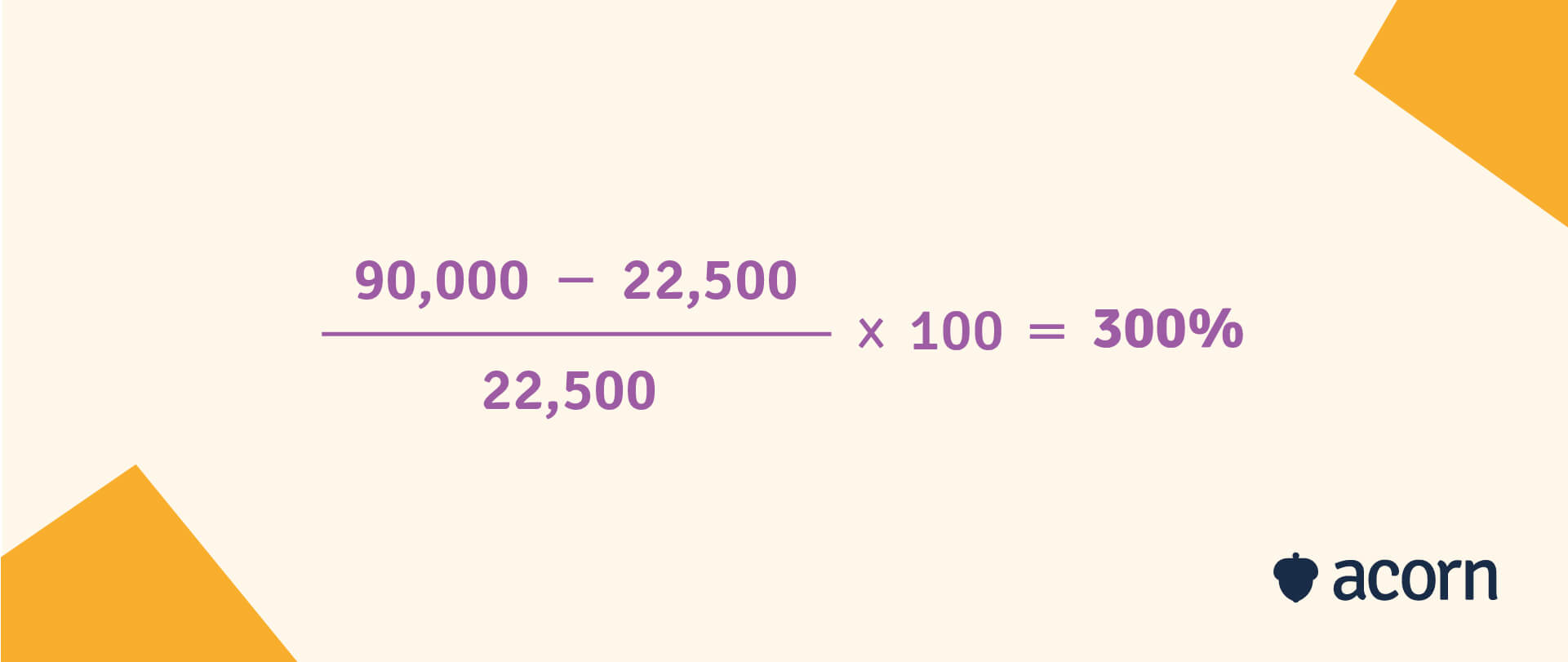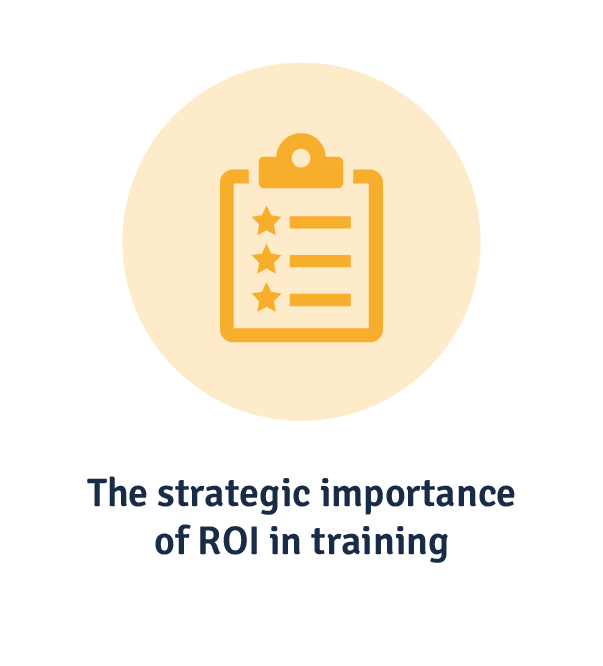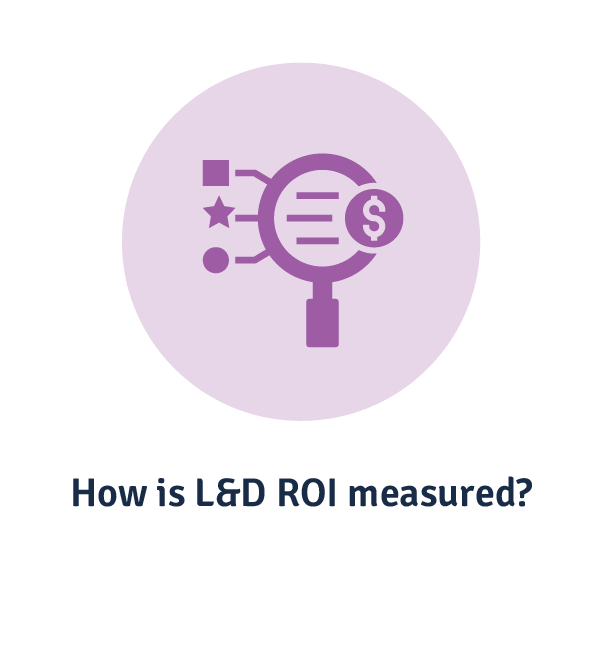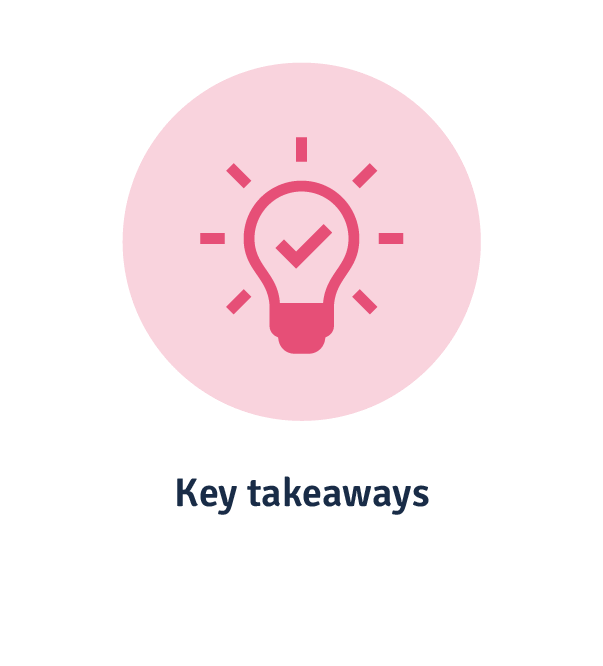Every company needs to invest in training to keep up with industry trends and progress. The only problem is, measuring training’s ability to help you progress can be difficult due to its intangible nature. Thankfully, there are some ways to calculate the business gains driven by a training program.
This is where measuring return on investment (ROI) comes in. Training ROI is a clear way of showing business outcomes and the financial return that training gains your organisation. But how do you calculate ROI, and what is a training ROI calculator?
In this guide, we’ll take a look at how you can measure the ROI of your training courses on your business goals and priorities.
What is ROI in training?
Training ROI refers to the dollar amount an organisation makes as a result of investing in training. It focuses on the benefits to the organisation and business impact rather than the benefits to employees.
You can calculate training ROI with an equation that shows the monetary value returned to your organisation for every dollar spent on training programs.

What is not ROI in training?
Your training reports, annual training summary, attendance rate and completions are not training ROI. Of course, they’re important, but they aren’t the metrics your C-suite cares about.
The truth is that while your L&D teams knows and understands the value of training participation and completions, your C-suite is more concerned with what training can do for the business overall. That is, how much profit training brings to the organisation.
The strategic importance of ROI in training
When it comes to implementing training in your organisation, you need to make sure it serves a strategic purpose for your business. This means aligning with organisational objectives and delivering a workforce with the right capabilities to meet those objectives.
There are several strategic benefits to ROI training.
- Gaining buy-in. With no buy-in from stakeholders, your training program will be dead in the water. This means no learning and no development or improvement in knowledge, processes, or behaviours that can drive business strategy. You need your stakeholders to invest in training–and invest enthusiastically. Training ROI is just a way of proving the results enthusiastic investments will get you.
- Justifying your L&D budget. An overly generous training budget means you might spend too much on a program when you could have achieved the results for a much cheaper cost, using money that could have been used to strengthen different areas of your business. Too small a budget and you could be stuck with inadequate training programs for your business needs. Calculating your training ROI ensures you’re delegating the right budget to your L&D needs and getting the best training for the best cost.
- The effectiveness of training. Essentially, this is the whole point of calculating ROI. It shows the link between training and business impact. These are the measurable results that highlight the monetary value investing in training has for your organisation. At Acorn, we’ve pioneered the first ever performance learning management system (PLMS) for this purpose, designed to synchronise L&D with business performance.
How is L&D ROI measured?
There are a few ways in which ROI can be measured. We get into them below.
The Kirkpatrick Model
The Kirkpatrick Evaluation Model is a method for analysing the learning effectiveness of a training program across different stages of the learning journey. It has four levels: Reaction, learning, behaviour and results.

Level 1: Reaction
This is the most basic of learning levels. It focuses on measuring learner satisfaction among program participants. Key indicators include course completions, progress rates and whether learners use their new knowledge after training. This is post-training data that you can collect from participants to highlight areas that may need improvement in your training exercise.
Level 2: Learning
There are three main ways to determine the extent to which training participants have actually learned new behaviours:
- Increase in knowledge
- Change in attitude
- Improvement in skills.
To consider a behaviour as “evolved” you need to see a change in at least two of these areas. You can see improvement (or lack thereof) from observing whether employees have improved their job performance since taking their training course.
Level 3: Behaviour
This stage looks at how workplace culture effects behavioural change. It focuses more on measuring the increase in morale, employee engagement and motivation. In other words, whether the culture drives the personal goals of employees to change, and whether the training actually reinforces behavioural change.
Level 4: Results
As the name suggests, this level is about measuring the business impacts and outcomes that come about as a result of employee training. This is your chance to reflect and ask how training affected your business overall.
Consider things like:
- Increased retention rates
- Higher customer satisfaction
- Increased productivity
- Increased sales
- Increased profit
- Reduced turnover.
This is the tangible and quantitative data that indicates the efficacy of your training program. The results should be obvious from performance reviews, customer feedback and sales numbers—and if not, then you know that either your metrics or training initiatives aren’t aligned to begin with.
The Phillips Model
The Phillips Model of Training Evaluation is similar to the Kirkpatrick Model, only it adds a fifth level of analysis: ROI.

Level 1: Reaction
Similar to the Kirkpatrick Model, this level focuses mainly on the reactions of employees to their training programs.
Level 2: Learning
This level, again like its Kirkpatrick Model counterpart, looks at whether knowledge and behaviours have been retained after completing a training session.
Level 3: Behaviour
On top of tracking behavioural change, this model also tracks environmental aspects that might be helping or hindering the implementation process of learning.
Perhaps behavioural change didn’t happen, and learning wasn’t retained or applied. The Kirkpatrick Model would leave it at that, but the Phillips Model delves into the why behind it. For example, maybe the organisation switched over to new methods or technologies, thus making the knowledge learned in training obsolete and unusable.
Level 4: Results
In the Phillips Model, this stage looks at all outcomes on the business, positive and negative. In other words, it will show the benefits of training—and the costs. For example, maybe your sales are up since implementing training, which is a positive outcome. But on the other hand, a negative outcome is a decrease in customer satisfaction.
Level 5: ROI
Your ROI looks at the link between training and business results.
Start by collecting your results from the first four stages. You can use the figures from these metrics to convert data into a clear dollar value.
- Resource development costs: The cost of creating and implementing your training program, including the cost of your LMS software.
- Time spent: The time your employees spend in training.
- Implementation costs: Other costs involved such as space required, technical support, or equipment.
For example, let’s say you’re looking into training to boost your sales. We’re talking marketing and sales training to have the best chance at increasing your sales. The profits from sales after training is complete will be your total benefits.
Now let’s say you spent $5,000 purchasing an LMS and developing a course, and you have 100 employees who are paid $35 an hour who did five hours of training. That’s $17,500 for that time period. Let’s also say your learning system had no technical difficulties and went off without a hitch, accruing zero maintenance costs. That makes your total cost $22,500. And let’s say your total benefits (the profits you made from sales) were $90,000. Plug these values into your ROI formula and you get:

Which makes your training ROI 300%—a nice, solid number showing the training impact on your business outcomes.
Impact study
Essentially, this is about measuring the post-training impact on the business. It’s a simple, four-step process to calculating ROI.
Step 1: Set clear goals
This is your time to do evaluation planning and set goals for what it is you actually want to achieve here. Choose the key indicators you wish to measure, like customer satisfaction or how many sales were made.
Then you need to work out how you’ll collect your training data. This could be the number of participants in the course, how many courses were carried out, and, of course, how much the training program cost overall.
Step 2: Collect your data
Data collection is the step where your clearly set goals come in handy. Given training is rarely isolated to one area of the organisation, you might need to collect your training data from different departments to get an idea of the bigger picture, and it’s easier to do that when you can specify exactly what you want from department heads and middle managers.
For example, you’ll need data on metrics from both before and after training takes place so you can compare them, so it’s best that you specify dates.
Step 3: Analyse data
Data analysis is simple: Use the ROI formula to measure the monetary values of each of your key metrics. For example, what is the ROI of sales before and after training took place? While this method doesn’t find the overall training ROI for your business, it does break it down into smaller increments, or the other factors that affect overall ROI.
Step 4: Report
Like the title says, this is where you report on the quantitative and qualitative data you collected and analysed in the previous step. The report is where your impact study is collected, showing the impact training has had on each of your chosen indicators.
The impact of not calculating training ROI
When it comes down to it, ROI is about gauging the effectiveness of training by measuring the monetary returns the training has provided.
If you don’t measure your training ROI, you’re not going to know if your training program has actually had any positive effect on your organisation’s performance. Even worse, you won’t know if your training is inefficient for your workforce. You need training ROI to show the impact of learning and development on your organisation so you can ensure your organisation is on the right path to progress.
At the same time, throwing in some random metrics to calculate and calling it training ROI is not helpful to your business. Bad metrics have just as much of a negative impact on your organisation as not measuring training ROI at all, because they aren’t showing you any quantifiable data to help you understand how your training program is benefiting your business performance. You need to make sure you choose key metrics that are indicative of organisational performance (sales is an obvious one) to really show return on investment.
Not calculating your training ROI also means you have no way of knowing whether your L&D budget is a responsible one. You need your ROI training data to justify the set budget, lest you spend too much money for too little return.
Key takeaways
Remember, your ROI calculations are essential for justifying training costs and gaining stakeholder buy-in in L&D investment, so you need to prove its learning effectiveness. Regardless of the method you use to measure ROI, you need to ensure you’re choosing the key metrics that will show the average increase (or decrease, if that’s the case) in your business results. Training ROI is clear and convincing data for you and your c-suite that indicates the link between training and an increase efficiency and business results.
Related Reads on This Topic

The How, Why & What of Calculating Profit Per Employee for Financial Performance
Profit per employee is about calculating how efficient your workforce is. Read more to find out why it matters and how you can measure it…

How You Should Measure Learning Engagement for L&D ROI
When it comes to learning engagement, it’s more about the quality than the quantity. We’ll look at the metrics to use and which to avoid…

How to Benchmark and Calculate Revenue Per Employee
Revenue per employee is the first step to understanding opportunities for improvement in your business. We break down how to calculate RPE…




